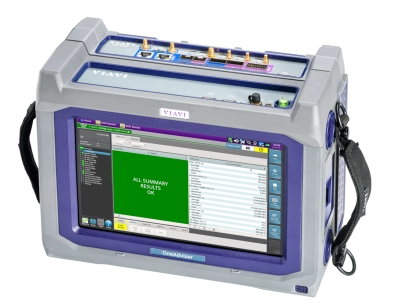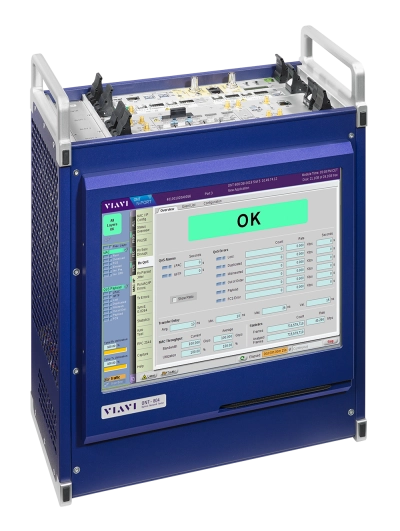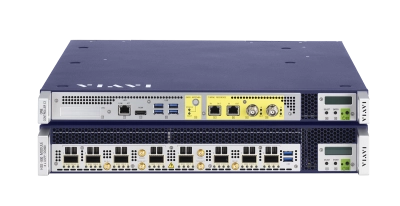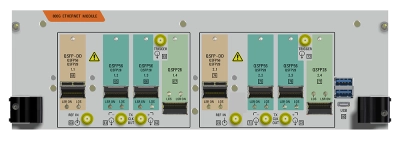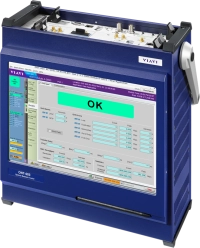400G
Industry-Leading 400G Testing Solutions
400G Technology is a critical tool for service providers and data center operators to meet the network capacity needs of a data-hungry world. VIAVI provides advanced test products for the lab and field to help the 400G ecosystem address this critical challenge.
Продукты
-

OneAdvisor 800 — платформа для тестирования транспортных сетей
Тестирование сетей в полевых условиях до 800G
-

OneAdvisor 1000 Platform
Scalable, network test platform up to 400G
-

ONT-800
Highly configurable, multi-protocol, multi-port test platform for R&D and system verification of optical...
-

ONE LabPro
High port count, multi-rate Ethernet network performance test system up to 1.6T integrating insightful Physical...
Testing 400G with VIAVI:
Versatile, automated VIAVI 400G test offerings support a broad range of industries including chip and transponder developers, network equipment manufacturers, internet service providers, and hyperscale data center operators. VIAVI test solutions are carefully crafted to enable a seamless transition from design and verification to post-deployment monitoring and assurance.
With unmatched optical transport testing knowledge and experience, VIAVI has leveraged a unique position in the industry to collaborate and strategize with top designers and committees throughout the 400G lifecycle. An unwavering dedication to innovation and interoperability has yielded a suite of advanced optical transport test solutions designed to optimize 400G performance from the lab to the field.
What is 400G?
400G is an important standard for high-capacity Ethernet client interfaces. Originally known as IEEE 802.3bs, 400G was officially approved in December of 2017 and is part of a broader family of related technologies including 200G, next generation 100G, and 50G Ethernet.
400G has driven the rapid development and adoption of new pluggable optical modules and switches. Sometimes referred to as 400GE or 400G Ethernet, the standard includes Forward Error Correction (FEC) to improve data reliability. Adoption of 400G network elements continues to accelerate as network operators and service providers reap the benefits of improved bandwidth and efficiency.
How Fast is 400G?
The term “exponential improvement” is a bit over used, but in the case of 400G, it is entirely applicable.
- Gigabit Ethernet, meaning an Ethernet connection that can transmit traffic at a rate of 1 gigabit per second (Gbps), was introduced in 1999.
- Terabit Ethernet is used to describe a switch fabric capable of handling numerous ports at speeds of 100 Gbps and above. True Terabit is one trillion bits per second.
- At 400 Gbps, 400G represents a 400-fold speed increase over the 1Gig Ethernet performance that was standard at the turn of the 21st century. To put this in perspective, the relative change approximates the difference in foot speed between a Galapagos tortoise and a cheetah in full pursuit.
- 400G Ethernet is so fast that it has even outpaced the ability of conventional laser on/laser off binary modulation to keep up.
- PAM-4 modulation has been developed to compensate, utilizing four amplitude levels rather than two to double the overall bit rate. Since the gap between signal levels is now much smaller, PAM-4 is also more susceptible to noise.
- The 400G transition brings more than just new Ethernet ports and modulation advancements. The paradigm shift necessitates adjustments throughout the networking ecosystem to provide flexibility and scalability of bandwidth deployment in new and unique ways.
400G Testing
Before 100G Ethernet, testing client optics was a much simpler task. Bit error rate (BER) could be quantified for each channel, with “zero” errors over a pre-defined time period often used as the pass/fail criteria. With non-return to zero (NRZ) giving way to PAM-4 modulation and FEC, 400G testing and validation have become much more complex. The sheer bandwidth increase alone has raised the bar for testing significantly.
Challenges
Higher speeds and the utilization of FEC and PAM-4 modulation bring amazing improvements in throughput, but can also lead to some of the inherent challenges of 400G testing.
- PAM-4 modulation introduces added complexity at the physical layer. 400G links will always have transmission errors, so simply quantifying the errors or testing based on “zero” errors no longer suffices.
- FEC technology and increased speed means some modules with higher raw error rates will operate error-free post-FEC and others will not. A more sophisticated understanding of error distribution and statistics is needed to discern acceptable error patterns from unacceptable ones and determine true root causes.
- FEC logic is complex and large. It needs to be tested for both logical validation as well as dynamic power performance.
- QSFP-DD (Quad Small Form Pluggable Double Density) pluggable optics modules for 400G are a marvel of complexity, with integrated lasers and drivers, high performance photodiodes and microcontrollers integrated into a very small form factor. These additional elements require strategies capable of 400G testing and validation of these components individually as well as within the context of the overall network structure.
- 400G Ethernet complexity makes it essential to control test equipment costs and test cycle times. 400G testing tools that stay ahead of the technology curve can mitigate these concerns, providing ready-made options to support the 400G transition and speed time-to-market for new products.
400G Testing Tools
Scalability, flexibility, and upgradability are among the essential characteristics of an effective 400G test solution provided by the VIAVI ONT 800G Ethernet Module. This versatile, multi-protocol, multi-port test platform, based on the latest 400G/200G (IEEE 802.3bs) standard, delivers 400G class Ethernet traffic generation along with advanced Ethernet alarm and error testing. The high-precision timing of the VIAVI Test Packet Format assures efficient Ethernet performance verification and accelerated validation.
The VIAVI ONT 400G CFP8 Module improves flexibility by supporting all 400G optical form factors. The industry’s first 400G test product includes advanced error analysis features and a QSFP-DD test slot. Field programmability supports ease of updates as standards evolve. The ONT 400G Module also includes FEC and PAM-4 modulation support. This test solution is an ideal platform for the design, development, and validation of next generation high-speed network components and systems.
400G Networks
Dense Wavelength Division Multiplexing (DWDM) has significantly increased fiber optic bandwidth. Using this method, a single fiber channel can transmit data at speeds of 400 Gb/sec. or more. With the network only as strong (or as fast) as its weakest link, 400G Ethernet bridges the bandwidth gap between the core routers and the DWDM equipment.
A 400G Ethernet interface allows the full capacity of network elements to be met at the correct density, allowing for seamless and unbridled throughput. Modern switch application-specific standard parts (ASSPs) such as the Broadcom Tomahawk family, can switch over 12 Terabits of traffic in one IC. 400G interfaces align this enormous bandwidth capability with front panel bandwidth density.
- FlexE
Flex Ethernet (FlexE) is a client interface standard first published by the Optical Internetworking Forum (OIF) in 2016. As the name implies, the intent is to provide a standard flexible enough to facilitate connectivity between the Ethernet and physical interface (server) by introducing a “shim” through the MAC and PCS layers. This allows a variety of MAC rates to be supported, independent of the physical interface.
FlexE provides a means of bonding multiple links. For example, 400G can be delivered as an individual pipe, two x 200G links or 4 x 100G links. Multiple test modules of the ONT platform enable the testing of FlexE-generated traffic at 400G and sub-line rates.
- FlexO
The ITU-T standards G.709 and G.709.1 for Optical Transport Networks (OTN) provide recommended interfaces and line rates for optical network elements connected through optical fiber links. OTN B100G is an extension of this standard for data rates beyond 100 Gbps.
ITU-T has utilized key concepts from IEEE 802.3 and the Optical Internetworking Forum (OIF) to determine how the same pluggable modules can be used for OTN interfaces. This is commonly referred to as Flexible ONT or “FlexO”, a mechanism to provides an OTN structure for 400GE and above, as well as FlexEthernet traffic.
Who Should Care About 400G?
The efficiencies gained through 400G implementation ripple throughout the high-speed networking ecosystem. This includes chip and module manufacturers, test equipment and service companies, internet mega-corporations, and telecom providers who rely upon these improvements to keep pace with the insatiable demand.
- Hyperscalers providing cloud services leverage 400G to meet the density needs of their growing data centers.
- Telecommunications providers must keep up with the ultra-connected user base using their own enormous data centers.
- Optical module developers benefit from the demand for more versatile and compact product offerings.
- Large-scale players are driving the move toward 400G at an accelerated rate to keep pace with server speed requirements.
- The advent of 400G allows networks to keep pace with the expectations for high-speed, seamless performance.
- Breakthrough 5G use cases like high-speed video streaming, virtual gaming, and the Internet of Things (IoT) are just a few of the applications that benefit from the 400GE networking.
100G and Beyond
Along with making good business sense, compatibility between 100G and 400G modules also simplifies testing and upgrades. The first 100G Ethernet solutions were introduced in 2010, with a slow ramp-up continuing through 2016. In the years since, 400G adoption has progressed on a multi-year trajectory as components and solutions become commercially available.
- Cost reduction and design enhancements for 100G modules have led to backwards-compatible technology. Advanced pluggable optic components developed for 100G make 400G Ethernet even more effective.
- The QSFP28, a quad small form factor hot-pluggable transceiver module capable of carrying 28G per lane, was instrumental in bringing 100G into the mainstream by 2017.
- The QSFP-DD is a new optical transceiver module type that is like a standard QSFP, but with an additional row of contacts to enable an electrical interface with twice as many lanes. The QSFP-DD delivers 6.4 Tb/s on a 1 RU host system card to support 400GE while providing double the 100G port density of the QSFP28.
- OSFP (optical small form factor pluggable) modules support 400G power requirements and include integrated heatsinks to meet the thermal demands. Unlike QSFP-DD, OSFP ports require special adapters for backwards compatibility with 100G QSFP.
- Hyperscale ICPs continue to focus on next-gen 800GE technology. While QSFP-DD is backwards compatible with 100G, its physical design provides less growth potential to support higher data rates. Since OSFP is 800GE-ready, industry giants continue to lean in on this module strategy, even before the supporting infrastructure is available.
- Cutting-edge science developed with 400G in mind, including PAM4 modulation and KP4 FEC, can also be used to increase density and reduce cost for 100G. As these technologies mature, 100G product offerings are expected to take full advantage of improvement opportunities engendered by 400G development.
More than Bandwidth
The monumental speed improvement of 400G represents a giant leap forward in Ethernet performance. However, increased speed and bandwidth are only part of the equation. 400G not only delivers more bandwidth, it provides the right bandwidth at the right density. Overall improvements in reliability, scalability, and power efficiency have made 400G a viable technology for our rapidly evolving network ecosystem.
The demands on cloud computing and telecom providers continue to push data center servers to the brink of their physical limits. Eliminating the bottleneck that Ethernet once presented impacts the entire networking landscape in immeasurable ways. Innovations like PAM4 have made this enhancement possible, while introducing a new set of obstacles for 400G testing and validation practices. Continuing to meet these challenges means leading the charge towards a new era of network performance.
Литература
White Papers и книги
Поддержка на каждом этапе работы
Мы оказываем техническую поддержку, предоставляем услуги, программы обучения и все необходимые материалы. Наша деятельность направлена на максимальное повышение отдачи от ваших капиталовложений в систему VIAVI.
Спросите у специалиста
Обращайтесь к нам для получения дополнительной информации и ценовых предложений. У нас есть специалисты, готовые дать правильный ответ на любой ваш вопрос.

